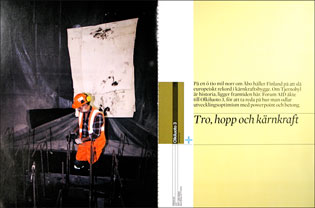

Soon to be translated.
I fly from the windmills and coal power of Denmark to the nuclear power of Finland. Had the mist lifted on the way I would have been able to see the Swedish reactors, which have either been shut down or chug on with credibility cracks and questions concerning their safety.
Nuclear power is good when it works, otherwise it still recalls, after all these years and in this new global development phase, a type of science-fiction-like nagging anxiety. The affinity with the Big Brother society is obvious; we know that there is something there, sometimes we can even see it, and maybe that’s necessary too, but most often its presence is elusive as it is discreet and odourless. We are forced to trust the judgement of those at the control panels.
Now as the Finns are building their country’s fifth and Europe’s largest nuclear power plant, Olkiluoto 3, it is taking place with the help of an expansive travelling nuclear family with building workers from some 30 countries. They check in at Gigawatt Road or Terrawatt Road in newly constructed barracks villages of faded yellow and grey-green wood and live here for different periods of time while they cast concrete and build impenetrable forests of reinforcing iron around the core or turbine hall.
At its largest early next year the family will comprise between 2,500 and 3,000 young and middle-aged men from Poland, Germany, France and more remote places, where a Finnish worker’s wages could make you think this is science fiction and astonish a whole village.
Right at the bottom of the reactor’s floor they say:
“Gute Arbeit.”
Inside the labyrinthian forest of steel pipes they say:
“Finland gut.”
In the plentiful brochure material about Olkiluoto 3, or OL3 as it is familiarly known, it is said that the nuclear power plant produces “prosperity for all of Finland.” Käthe Sarparanta, head of communications at TVO, Teollisuuden Voima Oy, the power company that owns Olkiluoto, says that deer and foxes often come up to the gates of the plant. The wild and the tame. A good environment and prosperity. Everyone is included.
In the autumn of 2004, Olkiluoto (which is on an island in the municipality of Eurajoki 100 kilometres north of Åbo) was visited by the local security committee from Forsmark municipality Östhammar. The Swedish visitors afterwards described, with a certain amount of admiration, how TVO had concentrated on getting the local schools and pupils on their side; this concerned sponsorship, lending laboratories, lecturing, nature walks, field trips and non-term-time courses at the nuclear power plant. At this point in time the plant had two older reactors delivered by Asea Atom, OL1 and OL2. Six months later work was started on OL3, which, with its 1,600 megawatts, will double the plant’s capacity and, according to the original but now revised plans, should be ready for start-up in 2009.
The question of terminal storage seemed to be solved. The used fuel will be placed almost 500 metres under the ground some kilometres from the reactors, following a parliamentary decision in principle, that showed 159 for and 3 against. In Eurajoki’s municipal council 20 members said yes and seven no. All the Social Democrats and Alliance parties were for, while the Centre party and Left were split.
The delegation from Östhammar established in their written report from their trip:
“The tangible difference we found was their way of reaching a decision. In Finland the preparation and decision over the fifth nuclear power plant and the terminal storage has gone relatively quickly. In Sweden the phase-out decision has taken a long time, and our preparations preceding the decision for terminal storage are estimated to take even longer.”
Even if the road to Olkiluoto has been asphalted once again and straightened out a bit, it looks like any old country road. A thinned out forest, normal everyday life in wooden houses, a simple shop by the roadside. On the other side of the fenced-off area, with a view to the sea, are summer cottages whose owners are now accustomed to catching sight of OL1’s and OL2’s rust-coloured metal boxes when they open their blinds.
OL3 will not leave either the deer or the summer guests unaffected. All in all the extend of the building will amount to one million cubic metres. The round reactor building will be 70 metres high, the turbine building will be 60 metres long.
A sea eagle that has lived here a long time regularly shows its displeasure with the new building by circling round on the onshore wind. The skeleton of the reactor seems to be growing organically from the bed-rock, surrounded by partially built concrete elements. The steel tub that will be one of the block’s containments has been parked a little bit away like a cargo ship taken out of operation. The workers’ bent bodies in yellowy-green waistcoats and orange overalls can be glimpsed inside the forest of vertical and horizontal pipes. Welding flames. Sturdy boots on rickety building steps.
Some time, a long time ago, a former Moderate party leader claimed that nuclear power was so safe that he could consider swimming in the reactor tank. The question is if a person with such an unconcerned attitude should be allowed into OL3; here protective walls are being built in several layers, four individual security systems are installed and the outer shell is designed to withstand earthquakes as well as a fully tanked passenger plane.

